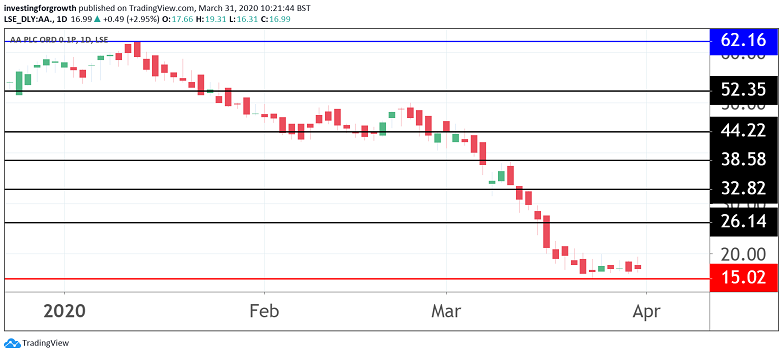AA shares hobbled by these two large thorns in the side
From 400p to 15p, our head of markets sums up prospects for shares in the fallen roadside repair firm.
31st March 2020 10:29
by Richard Hunter from interactive investor
From 400p to 15p, our head of markets sums up prospects for shares in the fallen roadside repair firm.

AA (LSE:AA.) remains a shadow of its former self, although it continues to improve on an incremental basis. Whether this is sufficient to repair previous damage remains to be seen.
The trading update, which replaces the full-year report for the time being following the Financial Conduct Authority’s (FCA) two-week moratorium on preliminary reporting, shows progress on some fronts.
In terms of the roadside business, the new partnerships with Admiral (LSE:ADM) and Uber (NYSE:UBER) should underpin a loyal and relatively stable membership base in excess of 3 million.
Meanwhile, the insurance unit has seen motor policies spike by 19% and elsewhere there was a notable reduction to the pension deficit. Trading margin remained flat at a respectable 35% and the unaudited pre-tax profit figure more than doubled, although it slipped 7% on an adjusted basis.
As is becoming the norm for companies in the current Covid-19 environment, AA is battening down the hatches in light of the nearer-term economic challenges to come. As such, there will be an added focus on the deferral or reduction of both operating costs and capital expenditure, while the final dividend has been suspended.
This markedly reduces what had been one of the few clear attractions of the stock, namely the dividend yield. The sharp decline in the share price had also been a factor, but a well-covered yield of over 12% has now been drastically reduced, even though the action is unlikely to be punished by increasingly understanding investors.

Source: TradingView Past performance is not a guide to future performance
However, two large thorns remain in the side of AA which are notable drags on prospects. On the one hand, the stock has been heavily shorted for some time now, unfortunately with some reason.
In addition, there remains a millstone around the company’s neck in the form of its net debt position, which remains stubbornly high at around £2.7 billion.
These factors are quite apart from the ongoing challenges to growth, such as increased competitor activity and intermittent regulatory pressures.
The initial share price hike in reaction to the numbers is of little consequence given the history. From an initial float price in June 2014 of 250p (let alone a subsequent high of 432p in March 2015), the current level of around 17p gives some indication of the enormity of the challenges ahead.
Even more recently, the decline has been substantial, with the shares having lost 82% over the last year, as compared to a 24% decline for the FTSE All-Share. The market consensus of the shares remains stuck at a “hold”, reflecting divided opinion on the company’s prospects.
These articles are provided for information purposes only. Occasionally, an opinion about whether to buy or sell a specific investment may be provided by third parties. The content is not intended to be a personal recommendation to buy or sell any financial instrument or product, or to adopt any investment strategy as it is not provided based on an assessment of your investing knowledge and experience, your financial situation or your investment objectives. The value of your investments, and the income derived from them, may go down as well as up. You may not get back all the money that you invest. The investments referred to in this article may not be suitable for all investors, and if in doubt, an investor should seek advice from a qualified investment adviser.
Full performance can be found on the company or index summary page on the interactive investor website. Simply click on the company's or index name highlighted in the article.